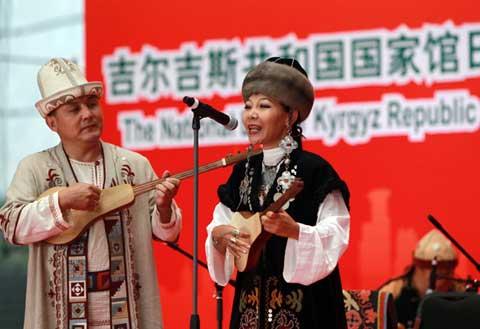The Kyrgyz Republic celebrated its National Pavilion Day at the World Expo on Wednesday.
"Kyrgyz" is believed to have been derived from the Turkic word for "forty," in reference to the forty clans of Manas, a legendary hero who united forty regional clans against the Uyghers.
So, it's no surprise that Kyrgyz Pavilion heavily features their traditional epic poem -- the Epic of Manas.
The Epic of Manas dates back to the 18th Century, though it is possibly much older. The eponymous hero of Manas and his Oirat enemy Joloy were first found written in a Persian manuscript dated to 1792. In one of its dozens of iterations, the epic poem consists of approximately 500-thousand lines. Kyrgyz historians consider it to be the longest epic poem in history.

The Kyrgyz Republic celebrates its National Pavilion Day at the World Expo on Wednesday.
Located in Central Asia, landlocked and mountainous, Kyrgyzstan is bordered by Kazakhstan to the north, Uzbekistan to the west, Tajikistan to the southwest and China to the east. Its economy largely relies on farming, especially sheep herding. As a result, wool products are very popular.
Feltmaking is widely practiced by nomadic people in central Asia where rugs, tents and clothing are regularly made. The non-woven cloth is produced by matting, condensing, and pressing woollen fibres. Some of the felt items they make are traditional, such as the classic yurt, while others are designed for the tourist market, such as decorated slippers.
The portable yurt, a felt-covered dwelling structure, is traditionally used by nomads in the steppes of Central Asia. The wooden crown of the yurt is itself emblematic in many central Asian cultures. It forms the main image on the flag of Kyrgyzstan.
The 40-rayed yellow sun in the center of the flag represents 40 warriors of the mythical hero Manas. The lines inside the sun represent the crown of a yurt, a symbol replicated in many facets of Kyrgyz architecture. The red portion of the flag represents the peace and openness of Kyrgyzstan.
To round out the celebration, Kyrgyz artists performed with their national instrument, the Komuz. Along with the yurt, the ancient fretless stringed instrument is one of the better-known Kyrgyz national symbols.
Source: CNTV
Editor: Xu Xinlei

